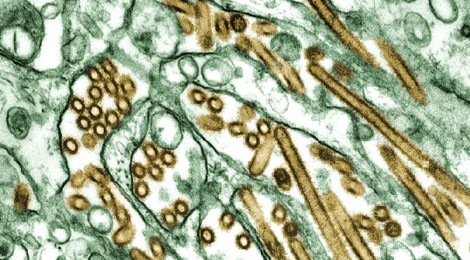
Population ecology of Avian Influenza virus
The influenza virus is one of the primary causes of acute respiratory infections in humans. Influenza is interesting from an ecological perspective, however, because it also infects a variety of other vertebrate species including horses, pigs, and birds. In birds, a large diversity of coexisting immunological subtypes and genetic strains circulate almost continuously, perhaps due to the fact that the virus is almost always non-pathogenic in the avian community. From a human perspective, it is important to understand the structure of this pathogen community because it makes up the gene pool from which any future human pandemic strain, including highly pathogenic strains, are likely to evolve. Avian influenza is also interesting from an ecological perspective, however, because it shows that a large diversity of closely related pathogens can coexist within the same community. Our studies of avian influenza virus, conducted together with collaborators at the Southeastern Cooperative Wildlife Disease Study and the University of Michigan, are aimed at understanding the role of environmental transmission in promoting this diversity. Theoretical studies by our group have shown the importance of virus particle durability in the environment to the dynamics and control of outbreaks in waterfowl (Rohani et al. 2009), the role that seasonality could play in promoting coexistence (Breban et al. 2009), and the conditions under which environmental transmission might evolve (Breban et al. 2010, Roche et al. 2011a,b). Empirical studies (Roche et al. 2014) have shown that these are some of the key factors maintaining the extraordinary diversity of the avian influenza virus hemagglutinin gene.
Related Publications:
- Roche, B., J.M. Drake, J. Brown, D. Stallknecht, T. Bedford & P. Rohani. 2014. Adaptive evolution and environmental durability jointly structure phylodynamic patterns in avian influenza viruses. PLOS Biology 12:e1001931. [online] [pdf]
- Brown, V.L., J.M. Drake, D.E. Stallknecht, J.D. Brown, H. Barton, K. Pedersen, & P. Rohani. 2014. Neutrality, cross-immunity and subtype dominance in avian influenza viruses. PLOS ONE. [online] [pdf]
- Barton, H., P. Rohani, D. Stallknecht, J. Brown & J.M. Drake. 2014. Subtype diversity and reassortment potential for co-circulating avian influenza viruses at a diversity hot spot. Journal of Animal Ecology. 83:566-575. [online] [data & code]
- Brown, V.L., J.M. Drake, D.E. Stallknecht, J.D. Brown, K. Pedersen & P. Rohani. 2013. Dissecting a wildlife disease hotspot: the impact of multiple host species, environmental transmission and seasonality in migration, breeding and mortality. Proceedings of the Royal Society Interface 10:2012080 [pdf] [online]
- Roche, B., J.M. Drake & P. Rohani. 2011a. The curse of the Pharoah revisited: evolutionary bi-stability in environmentally transmitted pathogens. Ecology Letters 14:569-575. doi: 10.1111/j.1461-0248.2011.01619.x [pdf] [online]
- Roche, B., J.M. Drake & P. Rohani. 2011b. An agent-based model to study the epidemiological and evolutionar dynamics of influenza viruses. BMC Bioinformatics 12:87. [pdf] [online]
- Breban, R., J.M. Drake & P. Rohani. 2010. A general multi-strain model with environmental transmission: invasion conditions for the disease-free and endemic states. Journal of Theoretical Biology 264:729-736. [pdf]
- Rohani, P., R. Breban, D.E. Stallknecht, & J.M. Drake. 2009. Environmental transmission of low pathogenicity avian influenza virus and its implications for pathogen invasion. Proceedings of the National Academy of Sciences USA 106:10365-10369. [online] [pdf]
- Breban, R., J.M. Drake, D.E. Stallknecht, & P. Rohani. 2009. The role of environmental transmission in recurrent avian influenza epidemics. PLoS Computational Biology 5(4): e1000346. doi:10.1371/journal.pcbi.1000346 [online] [pdf] [Supporting information]
This work was supported by the Centers for Disease Control and Prevention (5U19Cl000401), the James S. McDonnell Foundation, and the National Science Foundation (DEB-0917853)





